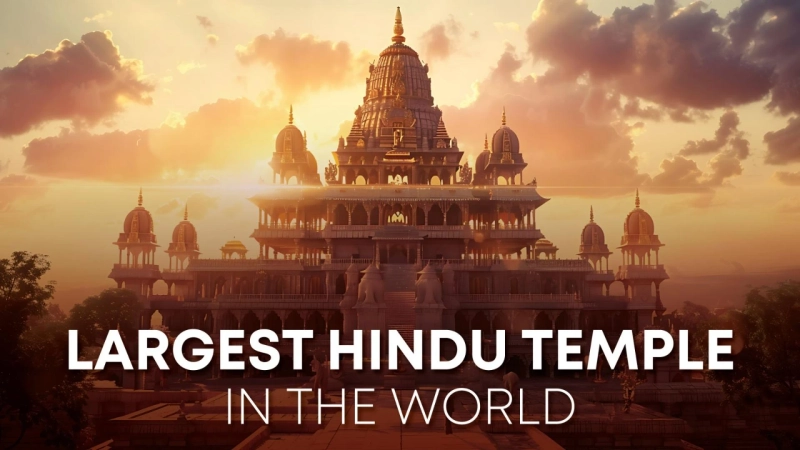Hindu temples are not only places of worship but also architectural marvels, reflecting the rich cultural heritage and spiritual traditions of Hinduism. Here, we explore the twelve largest Hindu temples in the world, known for their grandeur, historical significance, and spiritual ambiance.
1. Angkor Wat, Cambodia
Angkor Wat, located in Siem Reap, Cambodia, is the largest religious monument in the world, spanning over 162.6 hectares. Originally constructed in the early 12th century as a Hindu temple dedicated to the god Vishnu by the Khmer King Suryavarman II, it later transformed into a Buddhist temple. Its grandeur lies in its massive scale, intricate bas-reliefs, and the iconic central towers which resemble lotus buds.
2. Sri Ranganathaswamy Temple, India
The Sri Ranganathaswamy Temple, situated in Srirangam, Tamil Nadu, is one of the largest functioning Hindu temples, covering an area of about 156 acres. Dedicated to Lord Ranganatha (a reclining form of Lord Vishnu), this temple complex includes 21 magnificent towers, 50 shrines, and numerous water tanks. The temple\'s Rajagopuram (main tower) stands at 236 feet, making it one of the tallest temple towers in Asia.
3. Akshardham Temple, India
Swaminarayan Akshardham Temple in Delhi, India, is a modern architectural wonder. Inaugurated in 2005, it spans over 100 acres and showcases the intricate craftsmanship and rich cultural heritage of India. The temple, built from pink sandstone and white marble, features a central monument housing a 11-foot-high statue of Swaminarayan, surrounded by detailed carvings depicting stories from Hindu scriptures.
4. Thillai Nataraja Temple, India
The Thillai Nataraja Temple, located in Chidambaram, Tamil Nadu, is a major Shaivite temple dedicated to Lord Nataraja (Shiva as the cosmic dancer). Covering around 50 acres, it is one of the five Pancha Bhoota Stalams, representing the element of space (Akasha). The temple is known for its annual Natyanjali dance festival, which attracts classical dancers from all over the world.
5. Belur Math, India
Belur Math, situated on the west bank of the Hooghly River in West Bengal, India, is the headquarters of the Ramakrishna Math and Mission. The temple complex, spanning 40 acres, features a blend of architectural styles from Hindu, Christian, and Islamic traditions, symbolizing the unity of all religions. The main temple, dedicated to Ramakrishna Paramahamsa, was consecrated in 1938.
6. Prambanan Temple, Indonesia
Prambanan Temple, located in Central Java, Indonesia, is a 9th-century Hindu temple complex dedicated to the Trimurti: Brahma, Vishnu, and Shiva. This UNESCO World Heritage Site covers an area of about 39.8 hectares. It is known for its tall and pointed architecture, typical of Hindu temples, with the main shrine dedicated to Shiva standing at 47 meters.
7. Meenakshi Amman Temple, India
The Meenakshi Amman Temple, located in Madurai, Tamil Nadu, is a historic temple dedicated to Goddess Meenakshi (a form of Parvati) and Lord Sundareswarar (Shiva). Covering 15 acres, it features 14 gopurams (gateway towers), with the tallest standing at 170 feet. The temple is renowned for its elaborate carvings, vibrant sculptures, and the annual 10-day Meenakshi Tirukalyanam festival.
8. Brihadeeswarar Temple, India
Brihadeeswarar Temple, also known as the Big Temple, is located in Thanjavur, Tamil Nadu. Built by Raja Raja Chola I in the 11th century, it is dedicated to Lord Shiva and covers an area of 13 acres. The temple is famed for its massive Vimana (tower) standing at 216 feet, and the gigantic Nandi (bull) statue carved out of a single stone.
9. Somnath Temple, India
Somnath Temple, situated on the western coast of Gujarat, India, is one of the twelve Jyotirlinga shrines of Lord Shiva. Reconstructed several times over the centuries, the current structure, completed in 1951, covers an extensive area and stands as a symbol of resilience and cultural heritage. The temple\'s Shikhara (spire) rises to a height of 155 feet.
Conclusion
These temples not only represent the vast and diverse architectural styles of Hindu temple construction but also serve as important cultural and spiritual hubs. Each temple, with its unique history and religious significance, continues to be a beacon of devotion and a testament to the rich heritage of Hinduism. Visiting these temples provides not only a spiritual experience but also a glimpse into the intricate artistry and engineering skills of ancient and modern architects.



